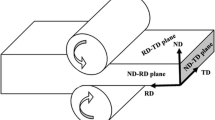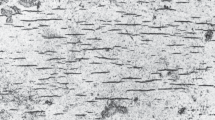We study the crystallographic textures and microstructures in longitudinal and cross sections of circular hot-rolled rods made of 25G2S and St3kp reinforcing steels. The distribution of orientations of the crystal is specific. It is described as a double “cylindrical” axial texture with 〈100〉 and 〈110〉 directions parallel to the axis of the rods. The anisotropy of elongation of grains is insignificant. We discuss the mechanisms of formation of the crystallographic texture responsible for the anisotropy of electrochemical corrosion of hot-rolled rods with circular cross sections made of steels with low contents of carbon. In steel rods with medium and high contents of carbon, the anisotropy of electrochemical corrosion is caused by the structural texture.







Similar content being viewed by others
References
R. W. K. Honeycombe, The Plastic Deformation of Metals, Edward Arnold, London (1984).
B. R. Kumar, R. Singh, B. Mahato, et al., “Effect of texture on the corrosion behavior of AISI 304L stainless steel,” Mater. Characteriz., 54, No. 2, 141–147 (2005).
D. A. Baranov, M. A. Linichkina, and A. I. Nesterova, “Influence of rolling on the corrosion resistance of high-strength cast iron,” Zashch. Met., 39, No. 4, 420–423 (2003).
V. Venegas, F. Caleyo, J. M. Hallen, et al., “Role of crystallographic texture in hydrogen-induced cracking of low-carbon steels for sour service piping,” Metallurg. Mater. Trans., A38(5), 1022–1031 (2007).
V. Venegas, F. Caleyo, T. Baudin, et al., “On the role of crystallographic texture in mitigating hydrogen-induced cracking in pipeline steels,” Corr. Sci., 53, No. 12, 4204–4212 (2011).
V. V. Usov and N. M. Shkatulyak, “Development of layered hydrogen-induced cracks in structural steel,” Deform. Razrush. Mater., No. 11, 36–40 (2006).
L. P. Vladimirov, “Anisotropy of corrosion properties of alloyed steel,” Mater. Sci., 2, No. 3, 210–211 (1967).
L. P. Vladimirov and E. I. Kargina, “Anisotropy of corrosion properties of carbon, low-alloy, and high-alloy steels,” Mater. Sci., 5, No. 1, 42–43 (1972).
Ya. D. Vishnyakov, A. A. Babareko, S. A. Vladimirov, and I. V. Egiz, Theory of Texture Formation in Metals and Alloys [in Russian], Nauka, Moscow (1979).
G. I. Bel’chenko and S. I. Gubenko, Foundations of Metallography and Plastic Deformation of Steel [in Russian], Vyshcha Shkola, Kiev–Donetsk (1987).
Y. Onuki, K. Okayasu, and H. Fukutomi, “Formation of {001} fiber texture in Fe–3 mass.% Si alloy during uniaxial compression deformation at elevated temperatures,” ISIJ Int., 51, No. 9, 1564–1565 (2011).
W. Skrotzki, R. Tamm, K. Kegler, and C.-G. Oertel, “Deformation and recrystallization textures in iron aluminides,” in: Proc. of the Internat. Conf. on Microstructure and Texture in Steels and Other Materials (February 5–7, 2008, Jamshedpur, India), India (2008), pp. 379–390.
A. A. Rusakov, X-Ray Diffraction Analysis of Metals [in Russian], Atomizdat, Moscow (1977).
A. N. Ivanov, Crystallography, X-Ray Diffraction Analysis, and Electron Microscopy [in Russian], Part 3, Moscow Institute of Steel and Alloys, Moscow (2009); http://www.crystallography.ru/Cryst_PhCh/01-Texture.pdf.
M. Zelin, “Microstructure evolution in pearlitic steels during wire drawing,” Acta Mater., 50, 4431–4447 (2002).
J. Jech, Heat Treatment of Steel, A Handbook, SNTL, Prague (1983).
Microstructures of Steels and Alloys [in Russian], http://www.microstructure.ru/ruqview1/forshura_4184.aspx?page=3.
S. N. Rodnikov, V. A. Likhachev, and S. V. Shishkina, and V. M. Kondratov, Problems of Physical Metallurgy in Galvanoengineering and Corrosion [in Russian], Gorky State University, Gorky (1989).
K. A. Lill, Electrochemical Investigation on the Corrosion Properties of New Classes of Light Weight Steels, http://www-brs.ub.ruhruni-bochum.de/netahtml/HSS/Diss/LillKirstenAgnes/ diss.pdf.
D. A. Baranov, “On the mechanism of influence of plastic deformation on the corrosion resistance of high-strength cast iron,” Zashch. Met., 43, No. 1, 55–58 (2007).
Author information
Authors and Affiliations
Corresponding author
Additional information
Translated from Fizyko-Khimichna Mekhanika Materialiv, Vol. 48, No. 2, pp. 31–38, March–April, 2012.
Rights and permissions
About this article
Cite this article
Shkatulyak, N.M., Tkachuk, O.M. A role played by the crystallographic texture in the process of corrosion of hot-rolled rods made of carbon steel. Mater Sci 48, 153–161 (2012). https://doi.org/10.1007/s11003-012-9485-y
Received:
Published:
Issue Date:
DOI: https://doi.org/10.1007/s11003-012-9485-y




